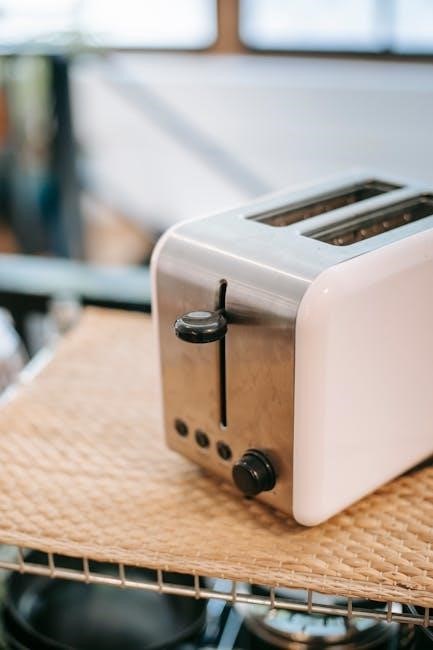Manual and electric chokes are essential components in carburetors, aiding cold engine starts by enriching the air-fuel mixture. Each type offers unique benefits, catering to different driving needs and preferences.
Overview of Chokes in Carburetors
A choke is a critical component in carburetors, designed to regulate airflow and enrich the air-fuel mixture during cold engine starts. It operates by restricting airflow, increasing fuel flow, and ensuring proper combustion. Manual and electric chokes serve the same purpose but differ in operation. A manual choke requires driver interaction, typically via a cable or lever, to open and close the choke valve. In contrast, an electric choke uses an electric current to automatically adjust the valve, eliminating manual intervention. Both types aim to improve starting performance, especially in cold conditions, but cater to different preferences and vehicle setups. Their design and functionality have evolved over time, offering distinct advantages for various applications.
Basic Differences Between Manual and Electric Chokes
Manual and electric chokes differ primarily in their operation and automation. Manual chokes require physical input from the driver via a lever or cable to adjust the choke valve, offering precise control. Electric chokes, however, operate automatically using an electric current to regulate the valve, eliminating manual intervention. This automation makes electric chokes more convenient, especially in modern vehicles. Manual chokes are simpler, cheaper, and often preferred for classic cars, while electric chokes provide ease of use and compatibility with advanced systems. These fundamental differences cater to distinct user preferences, vehicle types, and driving conditions, making each choke type suitable for specific applications.

Understanding Manual Chokes
Manual chokes rely on physical operation, typically via a cable or lever, to adjust the choke valve. They offer simplicity and direct user control over engine start-up conditions.
What is a Manual Choke?
A manual choke is a mechanical device in carburetors that requires physical operation, typically through a cable or lever, to regulate airflow. It enriches the air-fuel mixture during cold starts by restricting airflow, allowing more fuel to enter the engine. This simplicity offers direct control over engine performance, making it a cost-effective and reliable option for drivers who prefer hands-on adjustment. Manual chokes are often favored in classic cars and by enthusiasts who value their straightforward design and ability to fine-tune engine operation, particularly in varying weather conditions.
How Manual Chokes Operate
A manual choke operates by mechanically controlling airflow through the carburetor to enrich the air-fuel mixture during cold engine starts. When activated, typically via a cable or lever, it closes the choke valve, reducing airflow and increasing fuel proportion. This adjustment helps the cold engine ignite more efficiently. As the engine warms, the driver gradually opens the choke to restore normal airflow, preventing over-fueling. The process requires driver involvement, offering precise control over the air-fuel mixture and engine performance during startup and warm-up. This mechanical simplicity is favored in classic vehicles, aligning with the preference for hands-on driving experiences.
Advantages of Manual Chokes
Manual chokes offer simplicity and cost-effectiveness, making them a popular choice for classic cars and drivers who prefer mechanical control. They require no electrical connections, reducing potential failures and maintenance needs. Drivers can manually adjust the choke, allowing for precise control over the air-fuel mixture during engine startup and warm-up. This tactile operation is often favored by enthusiasts who enjoy hands-on driving experiences. Additionally, manual chokes are lightweight and easy to install, with fewer components prone to malfunction. Their straightforward design ensures reliability and minimal upkeep, appealing to those who value traditional automotive mechanics and the ability to fine-tune engine performance manually.
Understanding Electric Chokes
Electric chokes simplify engine starting by automatically enriching the air-fuel mixture, eliminating manual adjustments. They integrate seamlessly with modern vehicles, offering convenience and reliability through electronic controls.
What is an Electric Choke?
An electric choke is a carburetor component that automatically regulates the air-fuel mixture during engine startup. It replaces the manual choke’s mechanical operation with electronic controls, eliminating the need for driver input. Unlike manual chokes, electric chokes rely on an electric current to heat a bimetallic strip, which expands or contracts to open or close the choke valve. This automatic operation simplifies starting the engine, especially in cold conditions. The electric choke is typically connected to a 12-volt power source and integrates seamlessly with modern carburetors. Its design ensures consistent performance and reduces the risk of human error associated with manual adjustments;
How Electric Chokes Operate
An electric choke operates by using an electric current to heat a bimetallic strip inside the choke housing. When the engine is cold, the bimetallic strip is curled, keeping the choke valve closed to enrich the air-fuel mixture. As the engine warms up, a 12-volt power source is applied to the choke, heating the strip and causing it to uncurl. This movement opens the choke valve, gradually leaned out the mixture. The process is fully automatic, eliminating the need for manual adjustment. The electric choke’s operation is smooth and consistent, providing reliable cold starts and improving overall engine performance. Its design ensures minimal driver intervention, making it a convenient option for modern vehicles.

Advantages of Electric Chokes
Electric chokes offer several advantages, starting with their automatic operation, which eliminates the need for manual adjustments. This makes them more convenient, especially in cold weather, as they provide consistent and reliable cold starts. The electric choke’s ability to gradually open ensures a smooth transition from a rich to a lean air-fuel mixture, improving engine performance and reducing emissions. Additionally, electric chokes require minimal maintenance and are less prone to driver error compared to manual chokes. Their simplicity and ease of installation, typically requiring just a 12-volt wire connection, make them a popular choice for modern vehicles and drivers seeking hassle-free operation.

Comparison of Manual and Electric Chokes
Manual and electric chokes differ in operation, installation, and user involvement. Electric chokes offer automatic functionality, while manual chokes require driver input for precise control, impacting performance and convenience.
Design and Installation Differences
Manual chokes feature a straightforward design with a cable-operated mechanism, requiring physical adjustment by the driver. Electric chokes, however, utilize an automated system with a heating element controlled by an electric current. Installation of manual chokes is typically simpler, involving fewer components, while electric chokes often require additional wiring and connections to the vehicle’s electrical system. The design of manual chokes allows for direct user control, whereas electric chokes rely on temperature sensors and electronic signals to function. This difference in design impacts both installation complexity and overall system operation, catering to different user preferences and vehicle requirements.
Performance and Reliability
Manual chokes offer precise control over the air-fuel mixture, allowing drivers to fine-tune engine performance during cold starts. Their simplicity makes them highly reliable, with fewer components prone to failure. Electric chokes, while convenient, can sometimes malfunction due to electrical issues or sensor inaccuracies. Manual chokes excel in situations requiring manual adjustments, while electric chokes provide hands-free operation, ideal for modern vehicles. Both systems have proven reliable in their respective applications, but manual chokes are favored for their durability and lack of dependency on electrical systems. Electric chokes, however, offer consistent performance without driver intervention, making them suitable for everyday use.
Cost and Maintenance
Manual chokes are generally more affordable and simpler in design, requiring less maintenance due to fewer components. They are also easier to repair, as they rely on mechanical adjustments rather than electronic systems. Electric chokes, while more convenient, are typically more expensive and may require additional wiring and sensors. Maintenance for electric chokes can be more complex, involving checks on wiring and electronic components. However, their automatic operation reduces the need for frequent manual adjustments. Overall, manual chokes are cost-effective and low-maintenance, while electric chokes offer modern convenience at a higher initial and upkeep cost.

Real-World Applications and User Experiences
Manual chokes are often preferred in classic cars for their simplicity and driver control, while electric chokes are favored in modern vehicles for their convenience and ease of use.
Manual Chokes in Classic Cars
Manual chokes are a popular choice for classic car enthusiasts due to their simplicity and reliability. Owners appreciate the direct control over the choke mechanism, allowing for precise adjustments during cold starts. In forums and communities, users often highlight the ease of maintenance and cost-effectiveness of manual chokes. For instance, a manual choke cable can be easily adjusted or replaced without specialized tools, making it a practical option for vintage vehicles. Additionally, the lack of reliance on electrical systems appeals to those who prefer a more traditional driving experience. This hands-on approach resonates with many classic car restorers and drivers seeking authenticity.
Electric Chokes in Modern Vehicles
Electric chokes are widely adopted in modern vehicles due to their seamless integration with advanced fuel injection systems. They eliminate the need for manual intervention, automatically adjusting the air-fuel mixture based on engine temperature. Users praise the convenience and reliability of electric chokes, especially in cold weather, where they ensure faster and smoother starts. The automatic operation reduces driver effort, making them ideal for everyday commuting. Furthermore, electric chokes are less prone to human error, providing consistent performance and improving overall engine efficiency. Their compatibility with modern electronics enhances their appeal in contemporary automotive designs, solidifying their position as a preferred choice for today’s drivers.
User Preferences and Feedback
Drivers often express distinct preferences when comparing manual and electric chokes. Enthusiasts of classic cars frequently favor manual chokes for their tactile control and traditional driving experience. In contrast, modern vehicle owners lean toward electric chokes for their convenience and automatic operation, which simplifies cold starts. Some users highlight the reliability of manual chokes, while others appreciate the hands-free operation of electric models. Feedback suggests that electric chokes are preferred in everyday commuting due to their ease of use, especially in colder climates. However, occasional reports of malfunctioning electric chokes have led some to favor manual systems for their simplicity and durability.
Manual and electric chokes serve distinct purposes, with manual offering simplicity and control, while electric provides automatic convenience. Choose based on your vehicle and driving needs.
The primary distinction lies in operation: manual chokes require driver input via a cable, offering direct control, while electric chokes automate the process using sensors and electricity. Manual chokes are simpler, cost-effective, and preferred for classic or performance vehicles, allowing drivers to adjust the choke as needed. Electric chokes, however, provide convenience and consistency, especially in cold weather, with minimal maintenance. They are ideal for modern vehicles where ease of use is prioritized. Both systems aim to enrich the air-fuel mixture for efficient cold starts but cater to different user preferences and vehicle requirements.
Recommendations for Choosing the Right Choke
Choosing between a manual and electric choke depends on your vehicle type, driving habits, and personal preference. For classic cars or enthusiasts who value control, a manual choke is ideal. It offers simplicity and cost-effectiveness. Conversely, electric chokes are recommended for modern vehicles or drivers seeking convenience. They operate automatically, ensuring reliable starts without user intervention. Consider factors like climate—electric chokes excel in cold weather. Additionally, assess maintenance preferences; manuals require more driver involvement, while electrics need minimal upkeep. Ultimately, align your choice with your vehicle’s specifications and your lifestyle for optimal performance and satisfaction.

